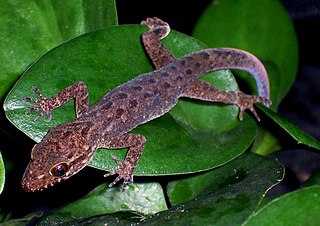Related Research Articles

Cyrtodactylus is a diverse genus of Asian geckos, commonly known as bent-toed geckos, bow-fingered geckos, and forest geckos. The genus has at least 300 described species as of 2020, which makes it the largest of all gecko genera.

Polypedates is a genus of frogs in the family Rhacophoridae, the shrub frogs and Paleotropic tree frogs. They belong to subfamily Rhacophorinae. Members of this genus are collectively known as whipping frogs. They occur in eastern and southern Asia.
Syringogaster is a genus of small ant-mimicking flies with a petiolate abdomen, a long prothorax, a swollen and spiny hind femur, and reduced head size and large eyes. There are 20 described extant species and two species known from Miocene amber from the Dominican Republic. It is the only genus in the family Syringogastridae.
The greater tree mouse is a species of rodent in the family Muridae. It is found only in Papua New Guinea.

The white-bellied hummingbird is a species of hummingbird in the family Trochilidae. It is found at forest edge, woodland, scrub and gardens in the Andes, ranging from northern Peru south through Bolivia to north-western Argentina. There are also lowland populations in Santa Cruz, Bolivia, and Mato Grosso, Brazil. It is generally fairly common.

The green-and-white hummingbird is a species of hummingbird in the family Trochilidae. It is endemic to the East Andean slope in Peru, where generally restricted to areas near humid forest. It is commonly seen at Machu Picchu. It closely resembles the white-bellied hummingbird, but lacks white to the basal half of the tail.

Heat shock protein 75 kDa, mitochondrial is a protein that in humans is encoded by the TRAP1 gene.
Crepidula carioca is a species of sea snail, a marine gastropod mollusc in the family Calyptraeidae, the slipper snails or slipper limpets, cup-and-saucer snails, and Chinese hat snails.
Hypsioma is a genus of longhorn beetles of the subfamily Lamiinae, containing the following species:
Hypsioma aristonia is a species of beetle in the family Cerambycidae. It was described by Dillon and Dillon in 1945. It is known from Brazil.
Hypsioma hezia is a species of beetle in the family Cerambycidae. It was described by Dillon and Dillon in 1945. It is known from Paraguay, Brazil and Argentina.
Hypsioma steinbachi is a species of beetle in the family Cerambycidae. It was described by Dillon and Dillon in 1945. It is known from Bolivia and Brazil.
Hypsioma affinis is a species of beetle in the family Cerambycidae. It was described by James Thomson in 1860. It is known from Brazil.
Hypsioma basalis is a species of beetle in the family Cerambycidae. It was described by James Thomson in 1860. It is known from Brazil.
Hypsioma cariua is a species of beetle in the family Cerambycidae. It was described by Galileo and Martins in 2007. It is known from Bolivia.
Hypsioma gibbera is a species of beetle in the family Cerambycidae. It was described by Audinet-Serville in 1835. It is known from Argentina, Brazil and Paraguay.
Hypsioma solangeae is a species of beetle in the family Cerambycidae. It was described by Galileo and Martins in 2007. It is known from Brazil.

Elliotomyia is a genus in the family of Hummingbirds.
Vallichlora is a genus of butterflies belonging to the family Geometridae.
References
- ↑ BioLib.cz - Hypsioma carioca. Retrieved on 8 September 2014.
- ↑ Heffern, Daniel; Santos-Silva, Antonio; Botero, Juan Pablo (2019). "A new genus and two new species of Apomecynini, a new species of Desmiphorini, and new records in Lamiinae and Disteniidae (Coleoptera)". Zootaxa. 4691 (5): 561–574. doi:10.11646/zootaxa.4691.5.8. PMID 31719382. S2CID 207934952.